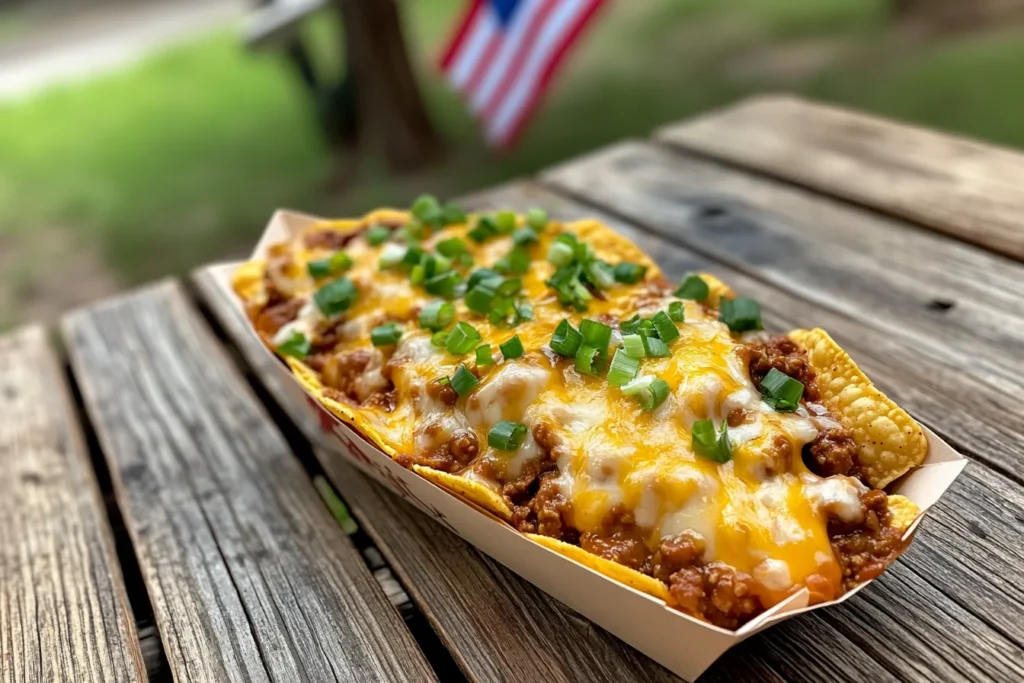Frito pie, that delicious concoction of corn chips, chili, and cheese, has been a beloved snack for decades. But is this crunchy, savory treat truly a Lone Star State original? Let’s dig into the crispy history of Frito pie and discover its true origins, regional variations, and why it’s become such a cultural phenomenon. From its humble beginnings to its widespread popularity, we’ll explore every cheesy layer of this iconic dish.
Table of contents
Just a Texas Tale?
The San Antonio Connection
Many Texans believe the origins of Frito pie is from San Antonio in the 1930s. The story goes that Daisy Dean Doolin, mother of Fritos inventor Charles Elmer Doolin, whipped up this cheesy delight. However, is this tale too good to be true? Let’s dive deeper into the origins of this beloved snack.
The legend paints a picture of a resourceful mother experimenting in her kitchen, combining her son’s crispy corn chips with hearty chili and gooey cheese. It’s a heartwarming story that’s been passed down through generations of Texans. Certainly, it’s easy to see why folks would want to believe in such a charming origin story.
The Corporate Kitchen Creation
Surprise, y’all! It turns out the official Fritos Chili Pie recipe wasn’t a mom-and-pop invention after all. Frito-Lay company records show their publicity department served it to the Dallas Dietetic Association in 1949. Talk about a plot twist!
This revelation sheds new light on the the origins of Frito pie. While it may not have the homespun charm of the San Antonio tale, it does highlight the innovative spirit of corporate America in the mid-20th century. Additionally, it demonstrates how a simple combination of ingredients can capture the public’s imagination and become a cultural touchstone.
The Evolution of a Snack Food Icon
Even though the exact origins of Frito pie might be disputed, there’s no denying its impact on American snack culture. Since its inception, whether in a home kitchen or a corporate test lab, the Frito pie has evolved and adapted to regional tastes and preferences.
For example, in some areas, you might find Frito pie served right in the chip bag, split open and topped with chili and fixings. This “walking taco” style has become particularly popular at sporting events and fairs. On the other hand, some restaurants serve a more upscale version, using gourmet chili and artisanal cheeses.

The Great Frito Pie Debate: Texas vs. New Mexico
Texas Cultural Significance
Frito pie has become deeply ingrained in Texas culture, particularly in relation to sporting events. It’s a staple at high school football games across the state, serving as the perfect grab-and-go snack for spectators This association with Friday night lights has made Frito pie an integral part of Texas high school culture and nostalgia.The dish also represents Texas ingenuity and resourcefulness. Charles Doolin, the inventor of Fritos, was from San Antonio, and the chip’s versatility in recipes like Frito pie showcases the state’s culinary creativity
New Mexico Cultural Significance
In New Mexico, Frito pie has evolved into a fundamental part of the state’s cuisine, despite not being originally native to the area. Since the late 1960s, it has proliferated at community events, state fairs, and rodeos, becoming a ubiquitous presence in New Mexican social gathering.The Five & Dime General Store in Santa Fe has turned Frito pie into a tourist attraction, with visitors making it a ritual to order the local delicacy at the store’s wooden counter. This has elevated Frito pie to an iconic status in New Mexican tourism.
Setting the Record Straight
Kaleta Doolin, daughter of Fritos inventor Charles Doolin, spilled the beans in her 2011 book. She proved that Frito-Lay’s team created the dish, not her grandmother or Hernandez. Sorry, y’all – sometimes the truth is less exciting than fiction!
Doolin’s research provides compelling evidence that the Frito pie was indeed a corporate creation. However, this doesn’t diminish the impact that regional variations, like the New Mexico version, have had on the dish’s popularity and evolution.
The Cultural Impact of the Debate
The heated debate between Texas and New Mexico over the origins of Frito pie speaks to the dish’s cultural significance. Both states take pride in their culinary traditions, and the Frito pie has become a symbol of regional identity.
Moreover, the controversy has only served to increase the Frito pie’s popularity. Food enthusiasts and curious tourists often make pilgrimages to both Texas and New Mexico to sample the different versions and decide for themselves which reigns supreme.
Shared Cultural Significance
In both states, Frito pie evokes a sense of nostalgia and communal identity. It’s associated with childhood memories, school lunches, and shared experiences at public events. The dish’s simplicity and accessibility have made it a unifying element across different social classes and demographics.The ongoing debate over its origins has ironically strengthened its cultural significance in both states. The rivalry has led to a protective attitude towards Frito pie, with residents of both Texas and New Mexico claiming it as part of their cultural heritage.Ultimately, Frito pie represents a unique blend of American junk food and traditional Southwestern ingredients, embodying the region’s culinary fusion and blue-collar, unpretentious character.
How to Make the Perfect Frito Pie
The Classic Recipe
Here’s the scoop on making a mouthwatering Frito pie:
- Grab a bag of Fritos Original Corn Chips
- Pour in some piping hot chili
- Top with diced onions and shredded cheddar cheese
- Optional: Add jalapeños and sour cream for extra zing
While this basic recipe is delicious on its own, many people like to add their own twist. For instance, some folks swear by using Fritos Scoops for extra crunch and chili-holding capacity. Others might opt for a vegetarian chili or even a plant-based cheese alternative for a modern take on the classic.
For more delicious ideas, check out our recipe for Frito Pie casserole, where you can learn how to make this classic dish from scratch!
Nutritional Information
| Ingredient | Calories | Protein (g) | Carbs (g) | Fat (g) |
|---|---|---|---|---|
| Fritos (1 oz) | 160 | 2 | 15 | 10 |
| Chili (1 cup) | 287 | 15 | 16 | 19 |
| Cheese (1 oz) | 114 | 7 | 1 | 9 |
| Onions (2 tbsp) | 8 | 0 | 2 | 0 |
It’s worth noting that while Frito pie isn’t exactly a health food, it does provide a good balance of macronutrients. The chili offers protein, the corn chips provide carbohydrates, and the cheese adds fat. Of course, moderation is key, as with any indulgent treat.
Variations on a Theme
While the classic recipe is beloved by many, creative cooks have come up with countless variations on the Frito pie theme. For example:
- Breakfast Frito Pie: Replace the chili with scrambled eggs and bacon for a morning twist.
- Dessert Frito Pie: Use cinnamon sugar Fritos topped with ice cream and chocolate sauce for a sweet treat.
- Seafood Frito Pie: Top Fritos with shrimp or crab in a creamy sauce for a coastal version.
These variations demonstrate the versatility of the basic Frito pie concept. Certainly, they show how a simple idea can spark culinary creativity across different regions and cultures.

Frito Pie: Beyond Texas Borders
A Friday Night Lights Favorite
Frito pie has become a staple at high school football games across Texas and beyond. It’s the perfect grab-and-go snack for cheering on your team!
The popularity of Frito pie at sporting events can be attributed to several factors. First and foremost, it’s easy to prepare and serve in large quantities. Additionally, it’s a satisfying and filling snack that can help spectators weather long games in all kinds of conditions.
Moreover, the tradition of eating Frito pie at football games has become a cultural touchstone, particularly in Texas. For many, the smell of chili and corn chips is inextricably linked with memories of crisp fall evenings, marching bands, and the thrill of competition.
Regional Variations
While Texas might claim Frito pie as its own, other states have put their spin on it. From New Mexico’s red chili version to creative takes across the country, this dish has truly gone national.
In New Mexico, as mentioned earlier, the Frito pie is often made with spicy red chili, reflecting the state’s love for heat and bold flavors. Meanwhile, in the Midwest, you might find Frito pie topped with Cincinnati-style chili, which includes cinnamon and chocolate for a unique flavor profile.
On the West Coast, health-conscious eaters have created versions using vegetarian or vegan chili, catering to diverse dietary preferences. In the South, some folks add a dollop of coleslaw on top for extra crunch and a tangy contrast to the rich chili.
Frito Pie Goes Gourmet
In recent years, upscale restaurants have begun putting their own spin on Frito pie, elevating the humble snack to new culinary heights. For instance, some chefs are using artisanal corn chips, craft beer-infused chili, and small-batch cheeses to create a more refined version of the dish.
These gourmet interpretations often come with a higher price tag, but they’ve helped introduce Frito pie to a new audience of food enthusiasts. Furthermore, they’ve sparked conversations about the nature of comfort food and the value of reimagining classic dishes.
The Cultural Significance of Frito Pie
A Symbol of Americana
Frito pie has become more than just a snack; it’s a symbol of American ingenuity and the country’s love for convenient, satisfying food. The dish embodies the spirit of mid-20th century America, when processed foods were seen as modern marvels and convenience was king.
Moreover, the Frito pie’s popularity across different regions and demographics speaks to its unifying power. Whether you’re at a high school football game in Texas, a street fair in New Mexico, or a gourmet restaurant in New York City, you can find some version of this beloved dish.
Frito Pie in Pop Culture
The cultural impact of Frito pie extends beyond the culinary world. It has been featured in numerous films, TV shows, and books, often used as a shorthand for Southwestern or Texan culture.
For example, in the popular TV series “Breaking Bad,” set in New Mexico, Frito pie makes several appearances, highlighting its importance in local cuisine. Similarly, country music songs have name-dropped Frito pie as a symbol of down-home cooking and simple pleasures.
The Economics of Frito Pie
From a business perspective, Frito pie has been a boon for Frito-Lay and other companies involved in its production. The dish’s popularity has helped drive sales of Fritos corn chips and has inspired numerous copycat products.
Additionally, the Frito pie has become a staple offering at concession stands, food trucks, and casual restaurants across the country. Its low cost of production and high profit margin make it an attractive option for food service businesses of all sizes.

The Future of Frito Pie
Adapting to Changing Tastes
As consumer preferences evolve, so too does the Frito pie. Health-conscious eaters are experimenting with whole grain chips, lean meats, and vegetable-based chilis. Meanwhile, adventurous foodies are incorporating international flavors, creating fusion dishes like Korean BBQ Frito pie or Indian-spiced Frito pie.
These adaptations ensure that Frito pie remains relevant in an ever-changing culinary landscape. They also demonstrate the dish’s remarkable versatility and enduring appeal.
Sustainability Concerns
In recent years, there has been growing concern about the environmental impact of processed foods like Fritos. In response, some companies are exploring more sustainable packaging options and ingredient sourcing methods.
This shift towards sustainability could lead to new variations of Frito pie that appeal to environmentally conscious consumers. For instance, we might see versions made with organic, locally-sourced ingredients or served in compostable containers.
The Global Reach of Frito Pie
While the Origins of Frito Pie has long been associated with American cuisine, it’s beginning to gain popularity in other parts of the world. As American food culture spreads globally, dishes like Frito pie are being discovered and adapted by international audiences.
In some countries, local snack chips are being used in place of Fritos, creating unique hybrid dishes that blend American and local culinary traditions. This global expansion of Frito pie speaks to its universal appeal and adaptability.
To summarize, while Frito pie may have its roots in Texas (or perhaps New Mexico), it has grown far beyond its regional origins. Today, it’s a beloved snack enjoyed across the United States and increasingly around the world. Its simple yet satisfying combination of flavors and textures has made it a cultural icon, adapting to changing tastes while maintaining its core appeal.
So, is Frito pie just a Texas thing? Not quite! While it’s got deep roots in the Lone Star State, this crunchy, cheesy delight has won hearts (and stomachs) far and wide. Whether you’re in Texas, New Mexico, or anywhere else, one thing’s for sure – Frito pie is a delicious piece of Americana that’s here to stay!

